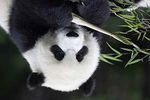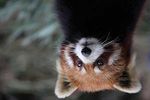China's Endangered Wildlife - Giant Pandas & Golden Snub-Nosed Monkeys - Joseph Van Os Photo ...
←
→
Page content transcription
If your browser does not render page correctly, please read the page content below
China’s Endangered Wildlife
Giant Pandas & Golden Snub-Nosed Monkeys
Deep within the forested slopes in some of China's largest remaining natural areas, dwell two of Earth's most
enigmatic and critically endangered animals. With populations of both species separated and isolated in fragmented
patches of forest by agriculture, villages, towns, highways and barren lands, these two spectacular creatures—the
giant pandas and golden snub-nosed monkeys—are the charismatic subjects of our unique and image-intensive
photo safari.
The biologically-rich Qinling Mountains of Shaanxi Province form an important
east-west watershed divide between China's two great rivers, the Chang Jiang
(Yangtze) and the Huang He (Yellow) River. In the sheltering broadleaf
woodlands of these "Szechuan Alps," the Qinling golden snub-nosed monkeys
(Rhinopithecus roxellana qinlingensis) share this protected habitat with some of
China's rarest plants and animals, including clouded leopards, takin and giant
pandas. Cold winter winds buffet these forests and snow occurs frequently within
the "golden-hair monkey" habitat range. These amazing monkeys can withstand
colder average temperatures than any other non-human primates—including
Japanese macaques, the snow monkeys.
At the Foping National Nature Reserve we work with park rangers who feed the
golden snub-nosed monkeys twice daily. By special arrangement, we
accompany the rangers to the feeding location where the monkeys are human-habituated and will climb down from
the trees—often with babies in tow. We are there a few months after the birthing season and we expect to "shoot"
females and their nursing babies at close range, along with the dramatically-colored and long-haired alpha males.
http://photosafaris.com/Photo-Tours/2020-Tours/Chinas-Endangered-WildlifeChengdu, the capital of Sichuan Province, is our gateway to the Bifengxia and Dujiangyan Giant Panda bases. The
Bifengxia center is the location to which the majority of the pandas housed at the Wolong Giant Panda Breeding
Center were translocated after the devastating Sichuan earthquake of May 2008. With an area of 144 acres
housing more than 100 pandas, it is now the largest captive giant panda breeding facility in the world. Here in this
sprawling compound we shoot the iconic pandas within some of the facility’s 58 enclosures in a variety of camera-
pleasing situations.
The Dujiangyan Giant Panda Base serves several different
functions. As the home to many of the sub-adults that are born
in the captive breeding program, this center houses small
groups of juvenile pandas in each of its 30 enclosures. We
photograph a variety of interactions—pandas climbing trees in
their compounds, rolling and tumbling, eating and relaxing.
Dujiangyan is also the arrival location for virtually all of the
young pandas returned to China from those born to adults
“loaned” to zoos throughout the world. (The rental fee for
pandas “loaned” to international zoos is one million dollars per year!) Capping off our trip is a visit to the famous
Terracotta Army of Xi’an. These iconic treasures are certainly to be included among the most remarkable relics of
ancient China and are one of the most remarkable archeological discoveries of all time.
Activity Advisory: Golden snub-nosed monkeys move around the forest on a daily basis but they
conveniently come to the trail for their twice-daily feedings. During our visit, expect a walk of one mile
(each way) with an elevation gain of 300 feet (or less)—at your own pace—to reach the monkey feeding
areas. The return walk is gradually downhill. Following our morning shoot we return to our hotel for lunch
and a short rest and then revisit the monkey feeding location for another shoot in the afternoon. Porters
will be available to carry camera gear for an extra fee.
Tour Itinerary
Day 1
Depart from home.
Day 2 (Oct 7 in Shanghai)
Arrive at Shanghai Pudong International Airport and transfer to our Shanghai city center hotel. Meet in
the hotel lobby at 6 PM for dinner at a nearby restaurant. (D)
Day 3
Fly to Chengdu. From the bustling city of Chengdu we have a two-hour drive to the Dujiangyan Giant
Panda Base located in the Shiqiao (Stone Bridge) Village of Qingchengshan. In the afternoon we have
our first photo session with the pandas.
The endangered giant panda is found only in western China. Because of human encroachment, the panda's
http://photosafaris.com/Photo-Tours/2020-Tours/Chinas-Endangered-Wildlifehabitat is now reduced to six isolated regions, mainly in
Sichuan. An estimated 1,000 to 1,500 wild pandas live
in the mountains within the rim of the Tibetan Plateau. A
type of bamboo called arrow bamboo is their favorite
food, but because bamboo is a poor nutrient source,
they must eat over 80 pounds of it a day! The giant
pandas’ foraging area is often limited by the type of
bamboo found within their home range, and their habitat is becoming progressively smaller due to
expanding agricultural practices, human population expansion, and logging. The lifespan of pandas in
the wild is unknown, but pandas in captivity typically live from 14 to 20 years. (BLD)
Day 4
We have the entire day—with a break for lunch—to photograph at the Dujiangyan Panda Base. This
new facility covers an area of 126 acres and serves several functions. It receives those young animals
born in international zoos upon repatriation, houses young non-breeders, and acts, in part, as the
panda rescue and quarantine facility focusing on pandas rescued from the wild that are sick or injured
so they can receive medical care and rehabilitation.
Within the compound you have a lot of flexibility to roam and photograph at your leisure. The pandas
may climb trees, interact in groups, and are generally accessible throughout the day. (BLD)
Day 5
Following a morning shoot at Dujiangyan we drive to the Bifengxia Giant Panda Breeding Center
located about 3½ hours away on the southeast edge of the Tibetan Plateau in Ya'an. We check into
our hotel in the late afternoon. (BLD)
Day 6
Situated at the top of the Bifengxia Mountain area with elevations from 3,630 to 5,940 feet, the first
stage of Bifengxia Giant Panda Breeding Center was completed in 2003. Today, the 144-acre center is
the largest captive giant panda breeding facility in the world. Each enclosure covers an area of about
one-quarter acre and provides naturalistic outdoor settings ideally conducive to panda portraiture. After
the 2008 Sichuan earthquake, most of the 63 captive pandas at the devastated Wolong Nature
Reserve were moved to Bifengxia. Soon thereafter, the world’s first twin pandas were born at the
center. In the succeeding years, scores of panda cubs have been born at Bifengxia. We shoot pandas
in their open enclosures through mid-afternoon and then return to Chengdu where we spend the night.
(BLD)
Day 7
This morning we photograph at the Chengdu Panda Base located a short drive from our hotel. This facility
http://photosafaris.com/Photo-Tours/2020-Tours/Chinas-Endangered-Wildlifehas more of a city garden park atmosphere than the
other panda centers we visit on this trip. The Chengdu
Panda Base houses more than 80 giant pandas, several
red pandas and a few other non-native animals. With
luck, if the weather is conducive to allowing them
outside, we photograph 3-month-old giant pandas in
their nursery enclosure.
Following lunch we board one of China’s amazing high-speed trains to Foping and then transfer to our
unique 4-star mountain hotel in one of the largest remaining forest habitats in China. (BLD)
Days 8–10
Morning dawns at the Foping Panda Valley in the forested Qinling Mountains of central China. Our goal
here is to concentrate on the valley’s population of endangered Qinling golden snub-nosed monkeys.
The "golden-hair monkey"—as the Chinese call it in English—is one of the most unusual primates in
the world and aptly named. The head, neck and underparts are bright gold, especially in males, and
the yellow-red to bright orange-red coat is strung through with a layer of long silver threadlike hairs that
catch the forest-filtered light. The species was long hunted for that golden pelt and—like many other
species—for use in traditional medicines.
In this scenic valley amid a temperate montane forest, a large population of golden snub-nosed
monkeys can be photographed as they are fed by local wildlife rangers during morning and afternoon
feedings. We have scheduled six photography sessions with the monkeys. (BLD)
Day 11
Following a final photo shoot with the monkeys we travel to Xi’an by high-speed train in the evening.
(BLD)
Day 12
This morning we photograph the famed Terracotta Army
—more than 6,000 life-size statues of warriors created to
guard the tomb of Qin Shi Huang, the first emperor to
unite China. The Terracotta Army has been designated
a UNESCO World Heritage Site. Later in the afternoon
we fly to Beijing with accommodations at the airport
hotel. (BLD)
Day 13 (Oct 18 from Beijing)
Depart Beijing Capital International Airport on flights home. (B)
http://photosafaris.com/Photo-Tours/2020-Tours/Chinas-Endangered-WildlifeTrip Details Tour Leader
Oct 06 - Oct 18, 2020
Fee: $7,595 from Shanghai, China depart Beijing
Deposit: $1,000
Limit: 14
WAYNE LYNCH
http://photosafaris.com/Photo-Tours/2020-Tours/Chinas-Endangered-WildlifeYou can also read

























































